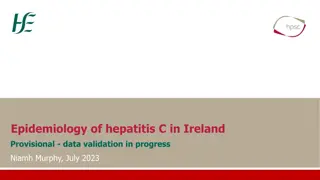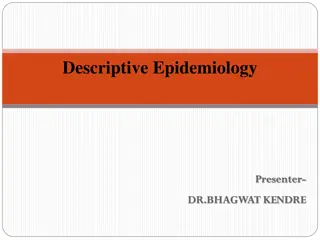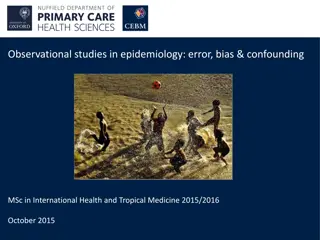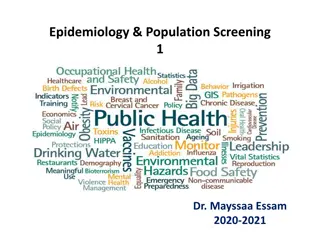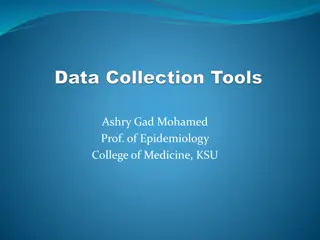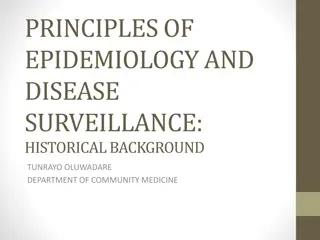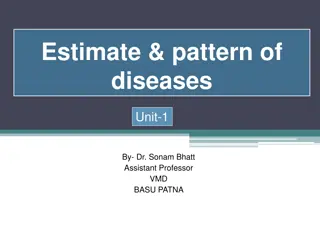Understanding Epidemiology: A Historical Perspective
Epidemiology is the study of health and disease patterns in populations. It involves analyzing distribution, determinants, and risk factors to inform public health policy, disease prevention, and clinical work. Modern epidemiology traces back to the mid-20th century, focusing on observational studies to understand diseases influenced by various factors over time. Notable historical figures like John Graunt, William Farr, John Snow, and Sir Richard Doll made significant contributions, advancing quantitative methods and uncovering crucial insights into public health.
Download Presentation

Please find below an Image/Link to download the presentation.
The content on the website is provided AS IS for your information and personal use only. It may not be sold, licensed, or shared on other websites without obtaining consent from the author. Download presentation by click this link. If you encounter any issues during the download, it is possible that the publisher has removed the file from their server.
E N D
Presentation Transcript
Basic Concepts of Epidemiology Part 1 Nina Gunnes August 27, 2020 8/27/2020 Lecture 1 - Fall 2020 1
What is epidemiology? Epidemiology is the study and analysis of the distribution (who, when, and where), patterns and determinants of health and disease conditions in defined populations. https://en.wikipedia.org/wiki/Epidemiology Study of diseases and other health outcomes Occurrence and distribution Course of disease Risk factors and causes The five Ws: who, what, when, where, and why? 8/27/2020 Lecture 1 - Fall 2020 2
What is epidemiology?, cont. Not restricted to infectious diseases and epidemics Epidemiological data forming the basis of several activities Public health policy Disease prevention Clinical work Relatively young science However, origin dating back several centuries 8/27/2020 Lecture 1 - Fall 2020 3
Modern epidemiology Dated back to the mid-20thcentury Increased occurrences of cardiovascular diseases and cancer Development of new designs and analytical methods Study of diseases influenced by several factors over a long period of time Mainly observational studies Experimental studies not always ethical (e.g., influence of tobacco or alcohol) 8/27/2020 Lecture 1 - Fall 2020 4
Important contributions John Graunt in the 17thcentury Introducing quantitative methods in epidemiology Analyzing mortality in London Pioneering work on the construction of lifetime tables William Farr in the 19thcentury Responsible for health statistics in England and Wales Systematic collection and analysis of population data Providing new insight into the population s health and diseases 8/27/2020 Lecture 1 - Fall 2020 5
Important contributions, cont. John Snow in the 19thcentury Studying the 1854 Broad Street cholera outbreak in Soho, London Mortality from cholera depending on the water supply Responsible for removing the handle of a public water pump on Broad Street Cholera transmitted in drinking water Sir Richard Doll and Sir A. Bradford Hill in 1954 Follow-up of 40,000 British medical doctors in the British Doctors Study Association between smoking and lung cancer (and other diseases) https://commons.wikimedia.org/wiki/File:John_Snow_memorial_and_pub.jpg 8/27/2020 Lecture 1 - Fall 2020 6
Important contributions, cont. 8/27/2020 Lecture 1 - Fall 2020 7
Incidence rate Number of new cases Total person time at risk Incidence rate = Measures the disease frequency over a specified time period Number of new cases divided by the total person-time at risk Number of new cases per unit of time Total person-time equal to sum of time during which each subject is at risk Commonly age-standardized Comparable over time and between countries (different age distributions) 8/27/2020 Lecture 1 - Fall 2020 8
Incidence rate, cont. time 8/27/2020 Lecture 1 - Fall 2020 9
Example 10.1 in Aalen et al. (2006) Incidence rate of malignant melanoma among women Data from the Cancer Registry of Norway (www.kreftregisteret.no) First time period: 1977 1981 Number of new cases of malignant melanoma: 1,321 Mean population of women (from Statistics Norway): 2,053,138 Second time period: 1997 2001 Number of new cases of malignant melanoma: 2,559 Mean population of women (from Statistics Norway): 2,252,622 8/27/2020 Lecture 1 - Fall 2020 10
Example 10.1 in Aalen et al. (2006), cont. 1,321 Incidence rate in 1977 1981: 12.9 new cases per 100,000 person-years 2,053,138 5= 0.000129 2,559 Incidence rate in 1997 2001: 22.7 new cases per 100,000 person-years Age-standardized incidence rates using a standard distribution of age In 1977 1981: 10.2 new cases per 100,000 person-years In 1997 2001 : 15.7 new cases per 100,000 person-years 2,252,622 5= 0.000227 The incidence rate 1.5 times higher after 20 years 8/27/2020 Lecture 1 - Fall 2020 11
Example 10.2 in Aalen et al. (2006) The Women s Lifestyle and Health Cohort Study (1991/92 1999) Norwegian-Swedish study of risk factors for malignant melanoma Women aged 30 50 years Women followed to the first occurring event after inclusion Emigration Death (whatever the cause) Diagnosis of malignant melanoma End of study (December 31, 1999) 8/27/2020 Lecture 1 - Fall 2020 12
Example 10.2 in Aalen et al. (2006), cont. Number of included women: 106,379 187 women diagnosed with malignant melanoma during follow-up Total person-time at risk: 866,668 person-years 187 866,668= 0.00022 22 new cases per 100,000 person-years Incidence rate: 8/27/2020 Lecture 1 - Fall 2020 13
Prevalence Number of cases Total number of subjects at risk Prevalence = Proportion of diseased subjects in the population at a given time Number without a unit of measurement Complicated relationship with incidence rate and duration Recovery Incidence Prevalence Death Figure based on Coggon et al. (1997) and Aalen et al. (2006) 8/27/2020 Lecture 1 - Fall 2020 14
Example 10.3 in Aalen et al. (2006) Malignant melanoma in Norwegian men and women Data from the Cancer Registry of Norway (www.kreftregisteret.no) Subjects diagnosed at some point and still alive as of 12.31.2001: 13,363 Total population at the end of 2001 (www.ssb.no): 4,524,066 www.kreftregisteret.no www.ssb.no 13,363 4,524,066= 0.0030 Prevalence of malignant melanoma: 0.3% or 300 cases per 100,000 subjects (or inhabitants) 8/27/2020 Lecture 1 - Fall 2020 15
References Aalen OO, Frigessi A, Moger TA, Scheel I, Skovlund E, Veier d MB. 2006. Statistiske metoder i medisin og helsefag. Oslo: Gyldendal akademisk. Coggon D, Rose G, Barker DJP. Epidemiology for the uninitiated. Fourth edition. Br Med J. 1997. https://www.bmj.com/about- bmj/resources-readers/publications/epidemiology-uninitiated. 8/27/2020 Lecture 1 - Fall 2020 16



